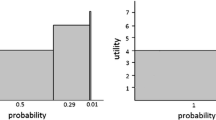Abstract
There has been very little contact between risk studies and more general studies of social decision processes. It is argued that as a consequence of this, an oversimplified picture of social decision processes prevails in studies of risk. Tools from decision theory, welfare economics, and moral theory can be used to analyze the intricate inter-individual relationships that need to be treated in an adequate account of social decision-making about risk. However, this is not a matter of simple or straightforward application of existing theory. It is a challenging area for new theoretical developments.
Similar content being viewed by others
References
Ashby E (1980) What price the Furbish lousewort?. Environ Sci Technol 14:1176–1181
Baram MS (1981) The use of cost-benefit analysis in regulatory decision-making is proving harmful to public health. Ann New York Acad Sci 363:123–128
Biwer BM, Butler JP (1999) Vehicle emission unit risk factors for transportation risk assessments. Risk Anal 19:1157–1171
Burgos R, Defeo O (2004) Long-term population structure, mortality and modeling of a tropical multi-fleet fishery: the red grouper Epinephelus morio of the Campeche Bank, Gulf of Mexico. Fish Res 66:325–335
Christensen-Szalanski JJJ, Bushyhead JB (1981) Physicians’ use of probabilistic information in a real clinical setting. J Exp Psychol Human Percept Perform 7:928–935
Coddington A (1971) Cost-benefit as the new utilitarianism. Polit Quart 42:320–325
Cohen B (2003) Probabilistic risk analysis for a high-level radioactive waste repository. Risk Anal 23:909–915
Condorcet ([1793] 1847) Plan de Constitution, presenté a la convention nationale les 15 et 16 février 1793. Oeuvres 12:333–415
Fischhoff B, Lichtenstein S, Slovic P, Derby SL, Keeney RL (1981) Acceptable risk. Cambridge University Press, Cambridge
Fischhoff B, MacGregor D (1982) Subjective confidence in forecasts. J Forecast 1:155–172
Gerrard MB (2000) Risks of hazardous waste sites versus asteroids and comet impacts: accounting for the discrepancies in US resource allocation. Risk Anal 20:895–904
Hampshire S (1972) Morality and pessimism. Cambridge University Press, Cambridge
Hansson SO (1993) The false promises of risk analysis. Ratio 6:16–26
Hansson SO (1998) Should we avoid moral dilemmas?. J Value Inquiry 32:407–416
Hansson SO (2001) The modes of value. Philos Stud 104:33–46
Hansson SO (2003) Ethical criteria of risk acceptance. Erkenntnis 59:291–309
Hansson SO (2004a) Weighing risks and benefits. Topoi 23:145–152
Hansson SO (2004b) Welfare, justice, and pareto efficiency. Ethical Theory Moral Pract 7:361–380
Hansson SO (2006) Economic (ir)rationality in risk analysis. Econ Philos 22:231–241
Hansson SO (2007a) Hypothetical Retrospection. Ethical Theory Moral Pract 10:145–157
Hansson SO (2007b) Philosophical problems in cost–benefit analysis. Econ Philos (in press)
Heinzerling L (2000) The rights of statistical people. Harvard Environ Law Rev 24(1):189–207
Heinzerling L (2002) Markets for Arsenic. Georgetown Law J 90:2311–2339
Hoerl AE, Fallin HK (1974) Reliability of subjective evaluations in a high incentive situation. J Roy Statist Soc 137(Part 2):227–230
Hynes M, Vanmarcke E (1976) Reliability of embankment performance predictions. In: Proceedings of the ASCE engineering mechanics division, specialty conference, Waterloo, Ontario, Canada. University of Waterloo Press, Waterloo
International Organization for Standardization (2002) Risk management – vocabulary – guidelines for use in standards. ISO/IEC Guide Vol 73
Kelman S (1981) Cost–benefit analysis. An ethical critique. Regulation 5:33–40
Le Grand J (1991) Equity and choice. An essay in economics and applied philosophy. Harper Collins Academic, London
Lichtenstein S et al (1982) Calibration of probabilities: the state of the art to 1980. In: Kahneman et al. Judgment under uncertainty, heuristics and biases, pp. 306–334
Luloff AE, Albrecht SL, Bourke L (1998) NIMBY and the hazardous and toxic waste siting dilemma: The need for concept clarification. Soc Natural Resour 11:81–89
McKerlie D (1986) Rights and risk. Can J Philos 16:239–251
Mishan EJ (1985) Consistency in the valuation of life: a wild goose chase? In: Ellen Frankel Paul, Fred D. Miller Jr, Jeffrey Paul, Ethics and Economics. Basil Blackwell, Oxford, pp. 152–167
Murphy AH, Winkler RL (1984) Probability forecasting in meteorology. J Am Statist Assoc 79:489–500
National Research Council (NRC) (1983) Risk assessment in the federal government: managing the process. National Academies Press, Washington, DC
Nozick R (1974) Anarchy, state, and utopia. Basic Books
Otway H (1987) Experts, risk communication, and democracy. Risk Anal 7:125–129
Pandey MD, Nathwani JS (2003) Canada wide standard for particulate matter and ozone: cost–benefit analysis using a life quality index. Risk Anal 23:55–67
Rechard RP (1999) Historical relationship between performance assessment for radioactive waste disposal and other types of risk assessment. Risk Anal 19(5):763–807
Royal Society (1983) Risk assessment. Report of a Royal Society Study Group, London
Sen A (1979) Utilitarianism and welfare. J Philos 76:463–489
Sen A (1987) On ethics and economics, Blackwell
Sen A (2000) Consequential evaluation and practical reason. J Philos 97:477–502
Simmons J (1987) Consent and fairness in planning land use. Bus Prof Ethics J 6(2):5–20
von Stackelberg KE et al (2002) Importance of uncertainty and variability to predicted risks from trophic transfer of PCBs in dredged sediments. Risk Anal 22:499–512
Thompson KM, Segui-Gomez M, Graham JD (2002) Validating benefit and cost estimates: the case of airbag regulation. Risk Anal 22:803–811
Thomson J (1985) Imposing risk. In: Mary Gibson (ed) To breathe freely. Rowman & Allanheld, pp 124–140
Usher D (1985) The value of life for decision-making in the private sector. In: Ellen Frankel Paul, Fred D. Miller Jr, Jeffrey Paul, Ethics and economics, Basil Blackwell, Oxford, pp. 168–191
Viscusi WK (2000) Risk equity. J Legal Stud 29:843–871
Author information
Authors and Affiliations
Corresponding author
Rights and permissions
About this article
Cite this article
Hansson, S.O. Social decisions about risk and risk-taking. Soc Choice Welfare 29, 649–663 (2007). https://doi.org/10.1007/s00355-007-0249-9
Received:
Accepted:
Published:
Issue Date:
DOI: https://doi.org/10.1007/s00355-007-0249-9




